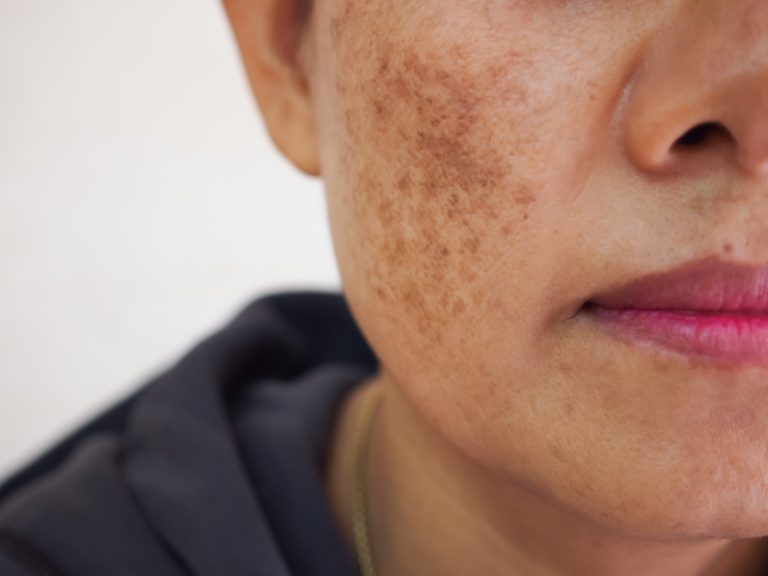Pigmentation means colouring.
Hyperpigmentation is a common condition that makes some areas of the skin darker than others. Extra melanin creates spots or patches that look brown, black, red or pink. The areas are not painful or itchy but can cause one to be self-conscious.
This condition can affect people of any race or ethnicity.

The Science Behind It
Melanin is a substance in the body that produces hair, eye and skin pigmentation. The more melanin produced, the darker your hair, eyes and skin will be.
It is a complex polymer that originates from the amino acid tyrosine. Melanin also absorbs harmful UV rays and protects cells from sun damage.
It is produced in melanocytes which are located in different areas of the body including
- Hair
- The innermost layer of skin
- Pupils and irises
- The substantia nigra and locus coeruleus (areas of the brain)

2 types of eumelanin – black and brown. It is responsible for dark colours in hair, eyes and skin.
This type of melanin pigments the lips, nipples and other pinkish parts of the body. People who have equal parts of eumelanin and pheomelanin have red hair.
While eumelanin and pheomelanin control the colors of things that can be seen physically, neuromelanin is responsible for the color of your neurons.
Your unique combination of eumelanin and pheomelanin is responsible for your hair, eye and skin colour. Typically, all humans have the same number of melanocytes. However, the amount of melanin produced by these melanocytes varies. Conditions like freckles are formed when there are clusters of melanocytes.
When you spend time out in the sun, the body produces more melanin which absorbs light from UV rays and redistributes it toward the upper layers of the skin. It also protects the genetic material stored in the cells by keeping out harmful UV rays. But melanin alone is not enough to protect skin from sun damage.

Some people make an excess of melanin which is known as hyperpigmentation. This presents as patches of skin that become darker than the surrounding skin.
Causes
Sun exposure
Hormonal imbalances and fluctuations
Skin injury and trauma
Types of Hyperpigmentation
Post-inflammatory hyperpigmentation (PIH)
A common acquired cutaneous disorder occurring after skin inflammation or injury
- Chronic
- More common and severe in darker-skinned individuals (Fitzpatrick skin types III-VI)
A result of the overproduction of melanin or abnormal melanin deposition in the epidermis or dermis following inflammation
Pathophysiology of PIH:
Inflammatory mediators trigger melanocyte hypertrophy and activity which increases melanin production in the epidermis
PIH VS PIE
The main difference between PIH and PIE is the pigmentation of the skin. PIH usually occurs in deeper skin tones, whereas PIE usually occurs in lighter skin tones.
Causes
Sun exposure
When the skin is exposed to excessive or prolonged sun exposure, it triggers an increase in melanin production as a defense mechanism to protect the skin from further damage. This heightened melanin production can result in several forms of pigmentation issues such as hyperpigmentation, melasma and sunspots.
Hormonal imbalances and fluctuations
The fluctuation and imbalance of hormones can stimulate the activity of melanocytes, the cells responsible for producing melanin, resulting in increased production and deposition of melanin in specific areas of the skin. This excessive melanin production leads to hyperpigmentation and the appearance of dark spots or patches on the affected areas.
Skin injury and trauma
Skin injury and trauma can contribute to pigmentation irregularities through post-inflammatory hyperpigmentation (PIH).
When the skin undergoes injury or trauma, such as cuts, burns, acne, or inflammatory skin conditions, an inflammatory response is triggered. Inflammatory cells release certain substances that stimulate the activity of melanocytes, the cells responsible for producing melanin.
The overproduction and accumulation of melanin in the affected area can manifest as dark spots, patches, or areas of hyperpigmentation.
Solutions
Pigmentation removal can be tricky, but it can be treated with effective treatment strategies and medication.
In sunny Singapore, you need to protect your skin from pigmentation by diligently applying a broad-spectrum sunscreen with a high SPF. When you are outdoors, protect your skin by seeking shade, wearing protective clothing, and using wide-brimmed hats. Without sunscreen, your skin can develop inflammation and redness.
You should also moisturise regularly to boost cell turnover and incorporate antioxidants in your skincare routine to prevent oxidative stress.
- Stay out of the sun. UV rays can increase inflammation and redness, possibly leading to post-inflammatory hyperpigmentation*
Search: SPF 45
- Moisturise regularly. Keeping skin moist can help to boost cell turnover and restore the skin’s lipid of fat barrier to help new skin cells stay healthy.
B5 Intensive series, B5 Hydrating Serum
*TIP: always apply a broad-spectrum sunscreen with SPF 30 or higher on a daily basis and re-apply if under prolonged sun exposure
Topical creams containing ingredients like hydroquinone, retinoids, kojic acid, or azelaic acid can be prescribed by a dermatologist to help with pigmentation. These creams work by inhibiting the production of melanin.
Other options to remove pigmentation include prescription-strength corticosteroids, which help with inflammation and certain types of hyperpigmentation. In some cases, oral medications like tranexamic acid or certain antioxidants may be prescribed to treat pigmentation.
- Certain topical and/ or oral medications can help in reducing pigmentation.
Pigmentation that has already developed on your skin can be hard to remove on your own, but professional pigmentation removal treatments can target the root cause of your pigmentation.
- Skin Resurfacing
Laser resurfacing can target and break down excess pigmentation in the skin. This treatment stimulates collagen production and promotes the growth of new, healthier skin cells. - Brightening & Tightening
Radiofrequency micro-needling creates controlled micro-injuries with the use of needles to stimulate the turnover of pigmented cells, leading to a more even skin tone. The collagen remodelling and skin tightening effects of radiofrequency energy can also help improve the appearance of pigmentation by reducing fine lines, wrinkles, and textural irregularities associated with pigmentation.

